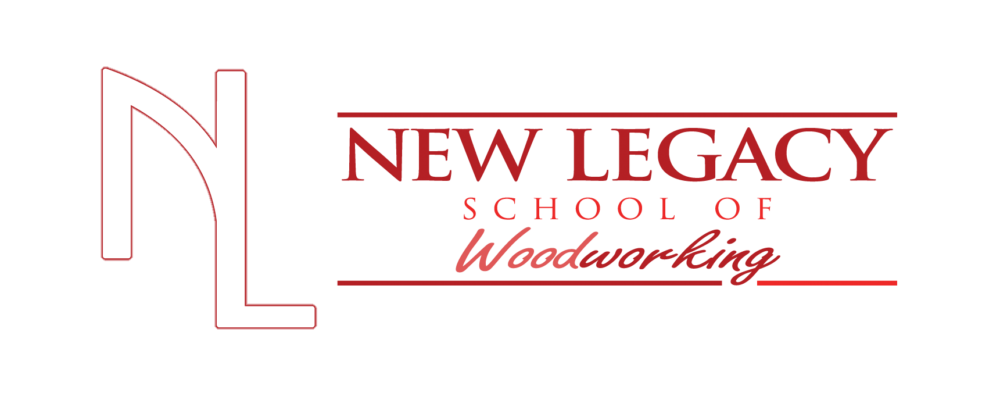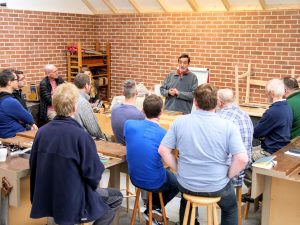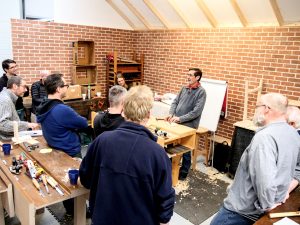2-Day Discovering Woodworking Course
To meet the ever-growing interest in hand-tool woodworking, our courses ensure that new and seasoned woodworkers become fully conversant creative artisans in their own right. Our training courses provide the solid and practical guidance once available only through traditional apprenticeships.
As a master craftsman, Paul developed this course as an introduction for students to better understand the fundamentals of their newfound craft. Whether new to woodworking or you want to learn the traditions of hand tools to compliment existing machine skills, this course is designed to get the foundation right.
All our workshops begin with hands-on training and cover the essentials of craftsmanship. We developed this two-day Discovering Woodworking course for you to learn the essentials of sharpening tools, the basics of shaping wood with edge tools and rasps, joinery layout procedures, joint making and other core skills every woodworker must master.
We show you how to develop and cut the primary joints that still prove as vital and practical for today’s woodworker as they have through generations and centuries past. Projects and exercises include making a wooden spatula, making three types of housing dado joints, making the dovetail joint and then the mortise and tenon joint.
The cost of the course is £265.00 GBP which includes materials. However, food and accommodation are not included.
Our next class will take place on the 22/23 September 2017 in our workshop located at Sylva Foundation, Long Wittenham, Oxfordshire.
The class will start at 9.00 and finish at 17.00.
Our 2-day woodworking classes on 31st March/1st April, 22nd/23rd September 2017 and 3rd/4th November 2017 are now full.
Woodworking Workshops
2-day Introduction to Woodworking
Module 1––Understanding hand tools
Tools, tool sharpening, restoration, setup and maintenance
Sharpening equipment
Sharpening is fundamental to all areas of hand tool woodworking and almost all of the tools we use must be sharpened to some degree. Developing a keen edge is simplified by around-the-bench discussion and demonstration. In this seminar we discuss optional differences between sharpening plates, stones and abrasive papers for developing sharp edges to edge tools such as planes, chisels, axes, draw knives, layout knives and others. We also discuss the files we use for sharpening the different tools including saws, scrapers, auger bits; the tools we rely on throughout woodworking, carpentry and joinery.
Chisels
Chisel sharpening, restoration and maintenance
Discussing different patterns of western-type chisels including bevel-edged, firmer and mortise-type chisels. We will also include discussion of Japanese-style chisels developed and used by Asian woodworkers too.
Planes
Plane sharpening, restoration, setup and maintenance
Discussing plane patterns and choices including the Bailey-pattern western hand planes, wooden planes and handmade user- or craftsman-made plane choices. We also discuss the use and need of dedicated plane types like plough planes, rebating planes and router planes.
Saws
Saw sharpening, restoration and maintenance of western-style handsaws including tenon saws, handsaws and bow and frame saws.
Discussing the different types and styles of western pattern resharpenable saws and considering the use of pull stroke Asian saws, bow and frame saws and more.
Layout knives
How to sharpen and use the joinery layout knife. Discussion on knifewall shoulder lines for joint making. How when and where to use the knifewall in relation to the wood itself and what this means in the development of accurate and exacting joinery.
Mortise/marking gauges
Modern developments have never quite replaced the traditional gauges used for centuries even though they do add something to the various concepts of joinery layout and other elements of woodworking including inlaying, rebating and so on.
Sliding bevels and protractors
Sliding bevels may seem self explanatory but these tools provide the ability for the transfer of angles into the work at the bench and we use them for other aspects of our work including tool sharpening, joint layout, angle finding and transferring important angles for the work we do.
Squares
The square is the single most important tool in the joiner’s workshop yet for the main part it is seldom considered or discussed. With so many square options to choose from, which one best suits the work of the joiner and furniture maker? We discuss these options and highlight the advantages of the most used square, the engineer’s combination square.
Pencil
Not complicated and widely used, the pencil influences our work in almost every layout procedure from developing shapes and placing the mapping lines on our work.
Module 2––Understanding joinery
Joinery for woodworking and furniture making
Understanding which joints work where is to investigate how joints work, their mechanical properties including advantages and weaknesses and where they can best be applied to particular projects. This hands-on joinery how-to is presented through short seminars and demonstrations as well as at-the-bench instruction in the construction and development of the three basic but most important woodworking joints.
The joints included in this seminar module are the Housing Dado, the Mortise and Tenon and the Dovetail joints. Each student will make at least one of each joint type.
We discuss the use and application of joinery and the development of woodworking joints, discussing and seeing their strengths, mechanical properties and applicable usage. We also show and discuss the various alternatives within the three-joint range.
Module 3––Learning to read the grain
Shaping three-dimensional shapes in wood
Shaping wood helps new woodworkers to discover the diversely impacting elements of grain structure and the importance of working ‘with the grain’. It’s all hands-on interspersed with short instructional seminars and demonstrations around the workbench. Instruction includes the development of a three-dimensionally shaped items, which will be one of three items (students choice), spatula, cutting board or a spurtle (porridge stirrer).
In this module we will be discussing the use of various tools used for shaping wood including spokeshaves, rasps, chisels, gouges and planes.


